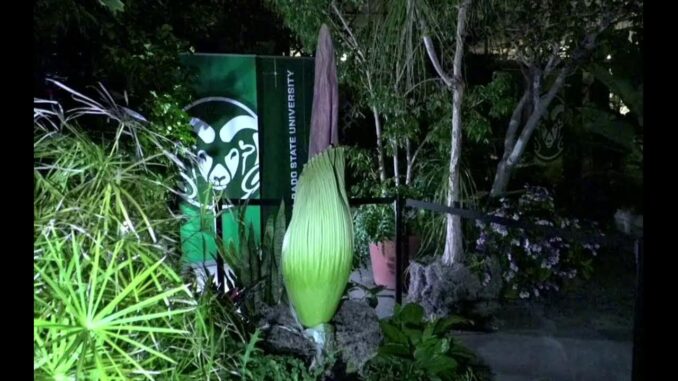
Allison Sylte | the SOURCE
It took eight years for Colorado State University’s corpse flower to bloom, and the wait was more than worth it.
More than 8,600 people visited the CSU campus over Memorial Day weekend to see (and smell!) Cosmo, a corpse flower that Plant Growth Facilities Manager Tammy Brenner brought back from a conference in 2016. After days of anticipation (which was captured in real-time on the CSU live stream), the flower finally began to bloom on Saturday night, emitting a foul odor that visitors compared to everything from “rotting Cheeto pie” to decaying meat.
“I’ve been watching the live stream religiously to be like ‘where’s it at? Do we need to get in line, should we camp?’” said Shiv Tuck, who came to visit Cosmo on Sunday morning.
CSU alumnus Bill Zanca, who lives in Breckenridge, was able to see and smell Cosmo while in Fort Collins visiting his daughter over the holiday.
“I’m pretty struck by the short amount of time between when it was not fully open and when it bloomed,” he said. “It’s such a gorgeous plant – it’s just amazing to see such a thing. I’ve never seen a plant like that before, so that’s pretty awesome.”
Researchers also got in the action, doing everything from taking samples to collecting seeds to measuring the air quality after the bloom.
Go to source.colostate.edu to check out the photo gallery to revisit a weekend that the CSU community won’t forget.
What is a corpse flower, and why does CSU have one?
The corpse flower, or Amorphophallus titanum, is the largest unbranched inflorescence (or collection of flowers acting as one) in the plant kingdom. They can grow up to 8 feet tall; and during bloom, their corpse-like smell lures pollinators like carrion beetles and flies.
The corpse flower is native to Sumatra, Indonesia, and there are estimated to be fewer than 1,000 individual specimens in the wild, according to the U.S. Botanic Garden.
Numerous botanical gardens and universities like CSU have begun cultivating corpse flowers to preserve its genetics and learn more about how these enigmatic plants thrive.
Brenner received Cosmo during a plant swap at the annual Association of Educator and Greenhouse Research Curators conference. Cosmo’s “parents,” Maudine and Woody, both came from Ohio State University and were “born” on May 24, 2013.
Brenner said life was fairly routine during Cosmo’s first few years at CSU. Throughout the year, the corpse flower produces a giant stem-like structure and a leaf but goes dormant in the fall when students return to campus from summer break.
“It looks a little sad, so we usually hide it in the back so no one thinks we’re killing it,” Brenner said.
This year was obviously different, and another bloom could happen within the next few years.
Year-round sights at the PGF Conservatory
Cosmo the corpse flower is one of the dozens of plants inside the Plant Growth Facilities Conservatory, which is located in a greenhouse on the east end of the CSU campus in Fort Collins.
It’s a key piece of the network of 11 Agricultural Experiment Stations scattered across the state, and the starting point for research around vital Colorado crops like corn, hemp, sorghum and wheat.
In addition to being home to numerous research operations, Brenner said the PGF Conservatory is truly a place for the community to enjoy, hosting everything from painting and drawing classes to writing workshops. It’s home to an assortment of plants that aren’t typically seen in Colorado, ranging from banana and pomegranate trees to lush ferns to multiple desert plants.
“A lot of our international students get really excited to be here because some of our plants make them feel like they’re at home,” Brenner said.
The conservatory is typically open from around 8:30 a.m. to 4 p.m. during the week and has numerous tables and chairs that allow people to take in the sights and enjoy this hidden gem year-round.
The Plant Growth Facilities team is asking for support to purchase new lighting for their facility so it can continue to be a resource to the public and advance important research.
All gifts to this project benefit the CSU-Agricultural Experiment Station Enrichment fund: col.st/h9X8W.
Support Northern Colorado Journalism
Show your support for North Forty News by helping us produce more content. It's a kind and simple gesture that will help us continue to bring more content to you.
BONUS - Donors get a link in their receipt to sign up for our once-per-week instant text messaging alert. Get your e-copy of North Forty News the moment it is released!
Click to Donate
